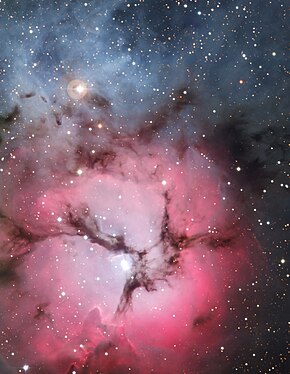
Back Driespletige Newel Afrikaans مسييه 20 Arabic Nebulosa Trífida AST NGC 6514 Azerbaijani M20 (аб’ект Месье) Byelorussian Патройная туманнасьць BE-X-OLD M20 Bulgarian NGC 6514 Breton Trifid (maglina) BS Nebulosa Trífida Catalan
| Emission nebula | |
|---|---|
| H II region | |
| reflection nebula and dark nebula | |
 | |
| Observation data: J2000 epoch | |
| Right ascension | 18h 02m 23s[1] |
| Declination | −23° 01′ 48″[1] |
| Distance | 4100±200[2] ly (1,260±70 pc) |
| Apparent magnitude (V) | +6.3[1] |
| Apparent dimensions (V) | 28 arcmins |
| Constellation | Sagittarius |
| Physical characteristics | |
| Radius | 21 ly |
| Notable features | a |
| Designations | M20, NGC 6514,[1] Sharpless 30, RCW 147, Gum 76 |
The Trifid Nebula (catalogued as Messier 20 or M20 and as NGC 6514) is an H II region in the north-west of Sagittarius in a star-forming region in the Milky Way's Scutum–Centaurus Arm.[3] It was discovered by Charles Messier on June 5, 1764.[4] Its name means 'three-lobe'. The object is an unusual combination of an open cluster of stars, an emission nebula (the relatively dense, reddish-pink portion), a reflection nebula (the mainly NNE blue portion), and a dark nebula (the apparent 'gaps' in the former that cause the trifurcated appearance, also designated Barnard 85). Viewed through a small telescope, the Trifid Nebula is a bright and peculiar object, and is thus a perennial favorite of amateur astronomers.[5]
The most massive star that has formed in this region is HD 164492A, an O7.5III star with a mass more than 20 times the mass of the Sun.[6] This star is surrounded by a cluster of approximately 3100 young stars.[7]
- ^ a b c d "NGC 6514". SIMBAD. Centre de données astronomiques de Strasbourg. Retrieved 2006-11-16.
- ^ Kuhn, Michael A.; Hillenbrand, Lynne A.; Sills, Alison; Feigelson, Eric D.; Getman, Konstantin V. (2018). "Kinematics in Young Star Clusters and Associations with Gaia DR2". The Astrophysical Journal. 870 (1): 32. arXiv:1807.02115. Bibcode:2019ApJ...870...32K. doi:10.3847/1538-4357/aaef8c. S2CID 119328315.
- ^ Cambrésy, L.; et al. (2011). "Variation of the extinction law in the Trifid nebula". Astronomy & Astrophysics. 527: A141. arXiv:1101.1089. Bibcode:2011A&A...527A.141C. doi:10.1051/0004-6361/201015863. S2CID 39501333.
- ^ Messier 20
- ^ "Trifid Nebula: A Massive Star Factory". Science Daily. August 26, 2009. Retrieved 2010-07-06.
- ^ Rho, J.; et al. (2004). "Chandra Observation of the Trifid Nebula: X-Ray Emission from the O Star Complex and Actively Forming Pre-Main-Sequence Stars". Astrophysical Journal. 607 (2): 904–912. arXiv:astro-ph/0401377. Bibcode:2004ApJ...607..904R. doi:10.1086/383081. S2CID 119090269.
- ^ Kuhn, M. A.; et al. (2015). "The Spatial Structure of Young Stellar Clusters. II. Total Young Stellar Populations". Astrophysical Journal. 802 (1): 60. arXiv:1501.05300. Bibcode:2015ApJ...802...60K. doi:10.1088/0004-637X/802/1/60. S2CID 119309858.
© MMXXIII Rich X Search. We shall prevail. All rights reserved. Rich X Search